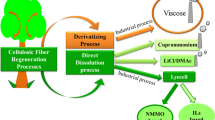Abstract
An ultrastructural study of the acetylation of cellulose was achieved by subjecting well characterized cellulose samples fromValonia cell wall and tunicin tests to homogeneous and heterogeneous acetylation. The study involved transmission electron microscopy observations on negatively stained microcrystals as well as diffraction contrast images of the cross sections of wall fragments at various stages of the reaction. These observations showed that the acetylation of crystalline cellulose proceeds by a reduction of the diameters of the crystals while their lengths are reduced to a lower extent. These results were corroborated by electron and X-ray diffraction experiments that showed that during the reaction there was a rapid decrease in the intensities of the equatorial diffraction spots of cellulose, whereas those located on the meridian or close to the meridian stayed constant. A model of acetylation of the cellulose crystal is presented. It is based on a non swelling reaction mechanism that affects only the cellulose chains located at the crystal surface. In the case of homogeneous acetylation, the partially acetylated molecules are sucked into the acetylating medium as soon as they are sufficiently soluble. In heterogeneous conditions the cellulose acetate remains insoluble and surrounds the crystalline core of unreacted cellulose.
Similar content being viewed by others

References
Bachhuber, K. and Frösch, D. (1983) Melamine resins, a new class of water-soluble embedding media for electron microscopy.J. Microsc. 130, 1–9.
Buras, E. M., Jr., Hobart, S. R., Hamalainen, C. and Cooper, A. S., Jr. (1957) A preliminary report on fully acetylated cotton.Textile Res. J. 27, 214–222.
Chanzy, H. and Henrissat, B. (1983) Electron microscopy study of the enzymatic hydrolysis ofValonia cellulose.Carbohydr. Polym. 3, 161–173.
Chanzy, H., Henrissat, B., Vuong, R. and Revol, J.-F. (1986) Structural changes of cellulose crystals during the reversible transformation cellulose I→III inValonia.Holzforshung 40(Suppl.), 25–30.
Chanzy, H. (1990) Aspects of cellulose structure. In Cellulose Sources and Exploitation. (J. F. Kennedy, G. O. Phillips and P. A. Williams, eds) New York: Ellis Horwood pp. 3–12.
Conrad, C. M. and Creely, J. J. (1962) Thermal X-ray diffraction study of highly acetylated cotton cellulose.J. Polym. Sci. 58, 781–790.
Gardner, K. H. and Blackwell, J. (1974) The structure of native cellulose.Biopolymers 13, 1975–2001.
Glegg, R. E., Ingerick, D., Parmerter, R. R., Salzer, J. S. T. and Warburton, R. S. (1968) Acetylation of cellulose I and II studied by limiting viscosity and X-ray diffraction.J. Polym. Sci., Part A2 6, 745–773.
Henrissat, B. and Chanzy, H. (1986) Enzymatic breakdown of cellulose crystals. InCellulose: Structure, Modification and Hydrolysis. (R. A. Young and R. M. Rowell eds) New York: Wiley Interscience, pp 337–347.
Hess, K. and Schultze, G. (1927) Über die präparative Abscheidung von Cellulosekrystallen aus Bastfasern.Justus Liebigs Ann. Chem. 456, 55–68.
Hess, K. and Trogus, C. (1931) Zur Kenntnis der Reaktionsweise der Cellulose.Z. Physik. Chem. B 15, 157–222.
Hurtubise, F. G. (1962) The analytical and structural aspects of the infrared spectroscopy of cellulose acetate.Tappi J. 45, 460–465.
Kanamaru, K. (1934) Über das Lichtbrechungsvermögen der Cellulose und ihrer Derivate. IV. Die Brechungsindices von Nitrocellulose und Acetylcellulose.Helv. Chim. Acta 17, 1436–1440.
Kuga, S. and Brown, R. M., Jr. (1987a) Practical aspects of lattice imaging of cellulose.J. Electron Microsc. Technique 6, 349–356.
Kuga, S. and Brown, R. M., Jr. (1987b) Lattice imaging of ramie cellulose.Polymer Commun 28, 311–314.
Malm, C. J., Tanghe, L. J. and Laird, B. C. (1946) Preparation of cellulose acetate. Action of sulfuric acid.Ind. Eng. Chem. 38, 77–82.
Revol, J.-F. (1982) On the cross-sectional shape of cellulose crystallites inValonia ventricosa.Carbohydr. Polym. 2, 123–134.
Revol, J.-F. and Goring, D. A. I. (1983) Directionality of the fibrec axis of cellulose crystallites in microfibrils ofValonia ventricosa.Polymer 24, 1547–1550.
Revol, J.-F. (1985) Change of thed spacing in cellulose crystals during lattice imaging.J. Mater. Sci. Lett. 4, 1347–1349.
Revol, J.-F., Bradford, H., Giasson, J., Marchessault, R. H. and Gray, D. G. (1992) Helicoidal self-ordering of cellulose microfibrils in aqueous suspension.Int. J. Biol. Macromol. 14, 170–172.
Serad, G. A. (1985) in Encyclopedia of Polymer Science and Engineering, Volume 3 (H. F. Mark, N. M. Bikales, C. G. Overberger and G. Menges eds) New York: Wiley Interscience, pp. 200–226.
Sisson, W. A. (1938) X-ray diffraction behavior of cellulose derivatives.Ind. Eng. Chem. 30, 530–537.
Sprague, B. S., Riley, J. L. and Noether, H. D. (1958) Factors influencing the crystal structure of cellulose triacetate.Textile Res. J. 28, 275–287.
Staudinger, H., In den Birken, K.-H.and Staudinger, M. (1953) Über den micellaren oder makromolekularen Bau der Cellulosen.Makromol. Chem. 9, 148–187.
Sugiyama, J., Harada, H., Fujiyoshi, Y. and Uyeda, N. (1985a) Observations of cellulose microfibrils inValonia macrophysa by high resolution electron microscopy.Mokuzai Gakkaishi 31, 61–67.
Sugiyama, J., Harada, H., Fujiyoshi, Y. and Uyeda, N. (1985b) Lattice imaging from ultrathin sections of cellulose microfibrils in the cell wall ofValonia macrophysa Kütz.Planta 166, 161–168.
Sugiyama, J., Vuong, R. and Chanzy, H. (1991) Electron diffraction study on the two crystalline phases occurring in native cellulose from an algal cell wall.Macromolecules 24, 4168–4175.
Tanghe, L. J., Genung, L. B. and Mench, J. W. (1963) Cellulose acetate. Acetylation of cellulose. In Methods in Carbohydrate Chemistry, Volume III, Cellulose (R. L. Whistler, J. W. Green, J. N. BeMiller and M. L. Wolfrom eds.) New York: Academic Press, pp. 193–198.
Van Daele, Y., Revol, J.-F., Gaul, F. and Goffinet, G. (1992) Characterization and supramolecular architecture of the cellulose-protein fibrils in the tunic of the sea peach (Halocynthiapapillosa, Ascidiacea, Urochordata).Biol. Cell 76, 87–96.
Author information
Authors and Affiliations
Rights and permissions
About this article
Cite this article
Sassi, JF., Chanzy, H. Ultrastructural aspects of the acetylation of cellulose. Cellulose 2, 111–127 (1995). https://doi.org/10.1007/BF00816384
Issue Date:
DOI: https://doi.org/10.1007/BF00816384



